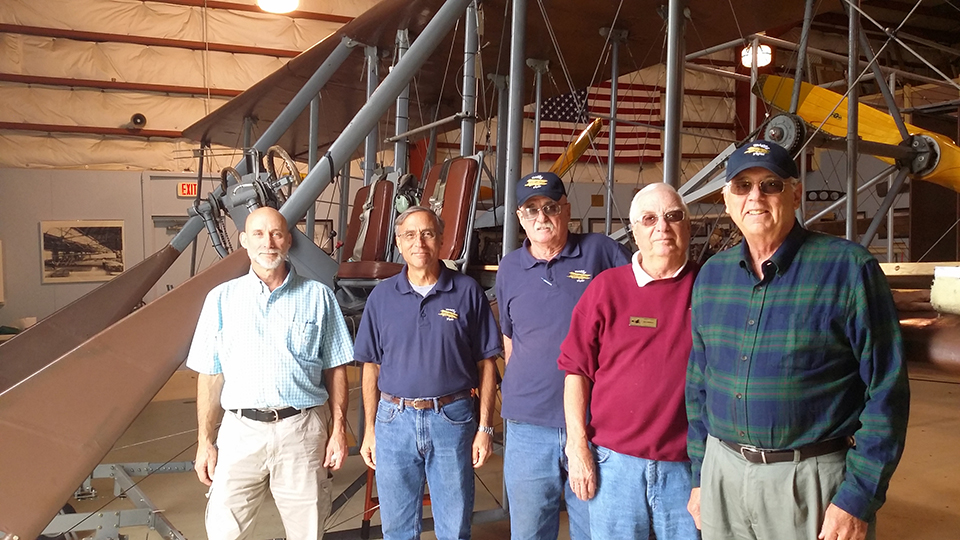EAA Chapter 5 Gets the Wright B Flyer Back in the Air
By Timothy R. Gaffney, EAA 287504
March 2017 - An all-volunteer group that flies a look-alike of the Wright brothers’ first production airplane is building a replacement aircraft with major help from EAA Chapter 5 in Middlefield, Ohio.
Since 1982, Wright B Flyer Inc. has flown and displayed the Wright “B” Flyer, a modern airplane built to resemble a Wright Model B — America’s first mass-produced airplane, manufactured in the Wright brothers’ Dayton factory and elsewhere under license beginning in 1910.
Besides making flybys and flyovers at regional air shows and other events, the one-of-a-kind machine has flown on both coasts and in Berlin, Germany. More than 4,500 individuals — including the late astronaut Neil Armstrong — have experienced the wind-in-your-hair sensation of pioneer flight on the airplane.
By 2014, the Brown Bird (nicknamed for its brown paint scheme) was requiring more maintenance work for its volunteer ground crew. The organization set out to design a new airplane to keep the mission active for the next 30 years.
The team at Wright B Flyer knew it could benefit from the experimental builder community to get the new airplane flying. So, in 2015 it took the airplane to EAA AirVenture to introduce EAAers to its project. The airplane was displayed in the Vintage Plaza and flew in two of the daily air shows.
Among the many EAAers who visited the airplane and spoke to Wright B Flyer volunteers was Tim Connor, EAA 220128, president of EAA Chapter 5, who thought his chapter would be interested in helping.
After AirVenture, Wright B Flyer members visited the Chapter 5 facilities at Geauga County Airport (7G8) in Middlefield, which is east of Cleveland. Chapter members also visited Wright B Flyer’s hangar-museum at Dayton Wright Brothers Airport (MGY) south of Dayton. After detailed discussions of requirements and capabilities, EAA 5 agreed to build the wings for the new aircraft.
Wright B Flyer provided detailed technical drawings produced with SOLIDWORKS engineering software donated by Dassault Systèmes SolidWorks Corp. and 3DVision Technologies, its Cincinnati-based reseller.
In February of 2016, materials started arriving and chapter members led by project manager, Curtis Cook, EAA 348851, began cutting out parts for the wing structures. The project was divided in two parts, the steelwork and the woodwork. The steel framework was laid out first. Basic parts were cut and fitted in the chapter shop. For more complex steel brackets, laser cutting was provided by MetalFab Group in Chagrin Falls.
EAA 5’s welders met exacting specifications to ensure the wings would fit into the center section being built by the WBF engineering staff 250 miles away in Dayton.
Fabricating the wingtip bows was another challenge. All the local fab shops declined the job, citing the tight radius and thin wall thickness as reasons the bends could not be made. The EAA 5 team developed a process in-house that overcame the issues and made the bends.
While the steelwork was in progress, a separate team of chapter members that specialize in woodwork were busy assembling doublers and capstrips on the ribs. As soon as the first steel ladder assembly was complete in mid-2016, the wooden ribs started going in, locking doublers were installed, and stringers glued in place.
The team developed an aluminum tool to maintain spacing and perpendicularity of the ribs on the spars while the adhesive cured. EAA 5 also designed and built a special laser device to verify perpendicularity to center-section attached points. This was used to tension the drag and anti-drag wires accurately and maintain alignment of the aileron attach brackets.
Chapter 5 finished the wings except for covering by the end of 2016. On January 14, 2017, two Wright B Flyer members picked up the wings at Geauga County and trailered them to Wright B Flyer, where they will be mated to the center section for structural static tests up to 3.8g. Successful tests will clear the way for final assembly.
It’s difficult to quantify how much the EAA 5 support contributed to the overall project, but Wright B Flyer estimates it shortened the timeline by a year. First flight of the new airplane is expected before the end of 2017, with public flights beginning in 2018. “The finished wings are beautifully built and will serve the new airplane for many years to come,” said Jay Jabour, EAA 1014225, chairman of Wright B Flyer.
If you would like to learn more about the Wright B Flyer, visit its website here!
If you have more questions about the Wright B Flyer wing assembly, you can contact EAA Chapter 5 at eaachapter5@gmail.com.


